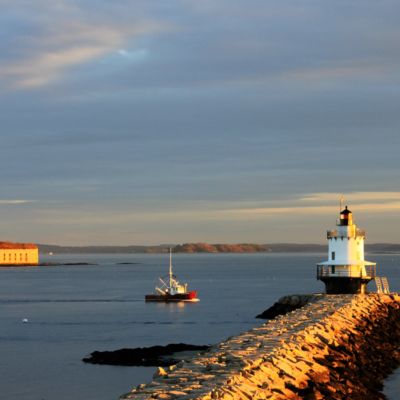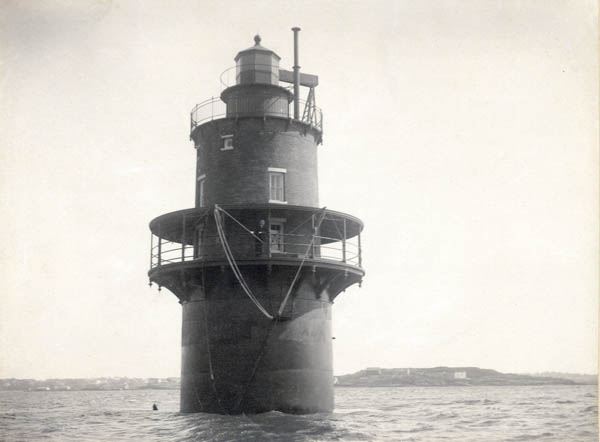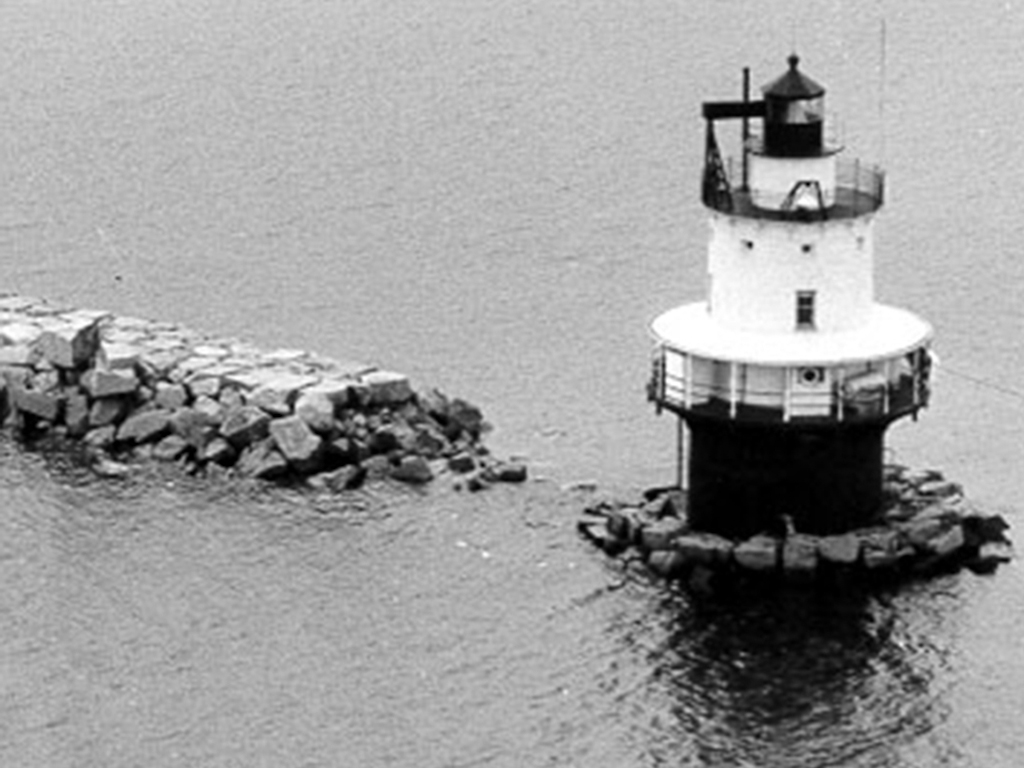history
Spring Point Ledge Lighthouse was built to warn mariners of a dangerous ledge that extended into the main shipping channel in Portland Harbor. The ledge, jutting out from the shoreline at Fort Preble in South Portland, was the scene of many shipwrecks and groundings. The ledge was marked by an ever-changing array of bell buoys, spar buoys, and nuns, but the buoys were of limited usefulness in bad weather and their positions were constantly being shifted by storm surges and ice.
By the late 1800s, Portland Harbor was one of the busiest on the east coast. The waterways bustled with schooners and steamships transporting goods and commodities, coal, food, and fish to and from the city. Additionally, there was thriving passenger traffic between Portland and other east coast cities and a growing stream of travelers to the nearby islands, which were becoming ever more popular as vacation destinations. By the time construction of Spring Point Ledge Lighthouse had been approved, seven steamship companies were carrying over 500,000 passengers annually past the dangerous ledge. Throughout that period an active military presence was also being maintained at Fort Preble in South Portland, Fort Scammel on House Island, and Fort Gorges on Hog Island Ledge.
Several high profile shipwrecks on the ledge finally prompted the steamship companies to begin a campaign for a lighthouse to mark the ledge. The Lighthouse Board was finally persuaded in April 1891 to establish a 5th order light at Spring Point Ledge. However, it was not until March 1895 that an appropriation of $45,000 was approved by the Lighthouse Board to begin construction, with a first installment of $20,000 released in March of that year and an additional $25,000 released in June 1896.
Advertisements for bids were released in April 1896 and on 8 May, the Lighthouse Board accepted the bid of Thomas Dwyer of New York in the amount of $27,490 and authorized the 1st Lighthouse District Engineer to enter into a contract with Dwyer for construction, with a completion date of 1 March 1897.
Before on-site construction of the tower could begin, Dwyer was required to assemble the three lower courses of the cylinder in the shop for inspection. Then, those courses were taken down and the remaining part of the shell, along with gallery brackets, beams, gallery floor, landing platforms, ladders, and ladder railings were to be assembled and inspected. A chisel was then used to number the plates according to a system established by the Board. Some of these numbers are still visible on the cylinder. The cylinder was also painted at this time. Afterward, it was to be reassembled on-site and sunk into position at the end of the ledge, where it would be filled with cement.
Dwyer began construction of the lighthouse in August, but in September while the cylinder was being placed in position, two sections were shattered by a storm, causing over $5000 in damage. This caused a significant delay in construction while Dwyer awaited replacement plates from the mill in Pennsylvania.
Shortly after construction resumed in October, Dwyer became embroiled in a dispute with the Lighthouse Board and the 1st Lighthouse District Engineer over the cement used in the caisson. While there is no indication that the cement used was actually flawed, Dwyer was not permitted to use materials that had not been tested and shown to be within specifications; he had apparently filled the caisson with cement without first submitting it for quality control testing.
The Lighthouse Board considered requiring the cement’s removal, but apparently, the 1st District Engineer determined that this was impractical. The cement was allowed to remain, but Dwyer was penalized $300 for the infraction.
By January 1897, Dwyer was in dire financial straits awaiting payment of the first installment of his contract. The cement was still an issue at that time, but the Board decided to pay Dwyer the first third of his contract with the stipulation that payment did not imply the Board’s acceptance of the work performed.
To add to Dwyer’s problems, the cement company sued him over the cement issue. Repeated requests by both Dwyer and the cement company for correspondence and information from the Lighthouse Board pertinent to the suit were denied by the Board, which refused to get involved. There is no record of how the lawsuit was finally resolved but the legal process was still ongoing at the end of 1898.
Despite all of this, construction of the lighthouse proceeded apace. In January 1897 the Board authorized the 1st District Engineer to reserve $3200 for the lens and illuminating apparatus. In addition, spring saw the purchase of the fog bell from the foundry in Boston for $180. Another $300 was authorized for the purchase of a Stevens bell striker, with an additional $100 allotted to set the striker up at Boston light station for testing.
By now, Dwyer’s contract had been extended to 1 April 1897 because of the numerous delays. On 8 April 1897, the Board authorized acceptance of the lighthouse and, after a few weeks of bureaucratic delays, the first keeper, William A. Lane, with 1st Assistant Keeper Harry Phillips, on 24 May 1897 lit the lamp at Spring Point Ledge lighthouse for the first time.
Originally, the Spring Point lighthouse was painted with one coat of red lead ground in linseed oil, followed by two coats of “prince metallic brown,” with a black lantern and lower cylinder. By October 1897, the Corps of Engineers recommended the color of the lighthouse be changed to its current black and white scheme, probably so the light would stand out from the nearby shoreline. The 1st District Engineer, deeming the job too much for the keepers to accomplish, began searching for a contractor to paint the tower, but in mid-November, the Corps of Engineers informed the 1st District Engineer that the keepers had, in fact, painted the tower themselves.
In early 1898, at the height of the Spanish American War, Portland Harbor was mined and both Spring Point Ledge Light and Portland Head Light went dark for approximately three months. Both resumed operation on the evening of 26 July.
One of the oddest incidents occurred on 20 August 1908, when the schooner Electric Flash ran into the lighthouse in broad daylight, demolishing one of the station’s lifeboats. The schooner then immediately put to sea. The replacement cost of the lifeboat was approximately $40. The owners of the Electric Flash commissioned a replacement lifeboat to be built in November, but in December they offered a 14 1/2’ peapod as a replacement, which was accepted by the Board.
On 1 May 1934, an underwater electrical cable was routed from the shore at Fort Preble to the lighthouse and Spring Point Ledge Lighthouse was finally electrified. A second submarine cable was laid between Spring Point light and the nearby Portland Breakwater lighthouse in Cushing’s Cove for many years, Portland Breakwater lighthouse was monitored by the keepers at Spring Point Light.
Continuing damage by ice resulted in the caisson’s encirclement in the 1930s with large granite blocks for protection and in 1951 the Corps of Engineers completed construction of a 50,000-ton granite breakwater atop the Spring Point Ledge that connected the lighthouse with the shore at Fort Preble.
In May 1960, the US Coast Guard automated the lighthouse and removed the 5th order Fresnel lens. A one-piece 375mm drum-shaped Fresnel lens was utilized in the light until the current apparatus, consisting of a 36-watt incandescent lamp and a 300mm Lexan plastic Fresnel lens, was installed. The whereabouts of the original 5th order lens was unknown during the intervening thirty years from its removal until 2009 when members of the Spring Point Ledge Light Trust finally located the lens in a private museum in Michigan.
Under the auspices of the Maine Lights Program, which was initiated by The Island Institute in Rockland, twenty-eight Maine lighthouses were identified as candidates for transfer to private ownership under the Coast Guard Reauthorization Act of 1996. In a ceremony in Rockport, Maine, on 20 June 1998, the Spring Point Ledge Light Trust accepted a ceremonial deed from US Coast Guard Admiral James M. Loy, Commandant, formally transferring ownership of the Spring Point Ledge lighthouse to the Trust. The US Coast Guard retains responsibility for the Aid to Navigation functions of the lighthouse under a Memorandum of Understanding. Spring Point Ledge Lighthouse is also listed in the National Register of Historic Places.
The Trust and its volunteer network have acted as good stewards for the lighthouse, raising funds for repairs, both small and large, to keep the lighthouse functional, safe, and secure:
- In 2004, the Trust completed its first major restoration project with the replacement of the heavily corroded roof plates of the main gallery.
- During 2012 cracks in the caisson were sealed and the lighthouse exterior was repainted.
- In 2013, portions of the interior were repainted.
- During the summer of 2017, we conducted the weathertight project, replacing the original ball bearing on top of the sector box navigational column and replacing the windows with authentic wooden sash shutters.
We are currently replacing the flagpole and the railings, and are planning more ambitious restorations projects for the next several years.
About the trust
The Spring Point Ledge Light Trust was formed by the Portland Harbor Museum in early 1998 to acquire ownership of the Spring Point Ledge Lighthouse. The lighthouse was one of 28 in the state of Maine which were being turned over to non-profit organizations and government agencies under the Maine Lights Program. The transfer of ownership took place in a public ceremony in Rockland, Maine, on June 20, 1998.
Our mandate is to maintain the structure in good condition, restore and repair it as necessary, and to educate the public and allow access whenever possible. The Trust is the sole owner of the lighthouse tower and some surrounding land (all underwater). The U. S. Coast Guard retains responsibility for maintenance of the light and electronic fog signal as an active aid to navigation.
officers of the board of trustees




The Spring Point Ledge Lighthouse is listed in the National Register of Historic Buildings and on the State of Maine Register of Historic Structures. The lighthouse has also been listed by the National Trust for Historic Preservation under the “Save America’s Treasures” program. As such, all maintenance and renovation must be in accordance with historic preservation guidelines. The Maine Historic Preservation Commission serves in an advisory capacity and has a covenant on the structure to ensure compliance.
One of the Trust’s most important tasks is that of educating the public about lighthouses in general and the Spring Point Ledge Lighthouse in particular. If anyone has any information about the lighthouse, especially photographs and information about former keepers, the Trust would like to hear from them.



